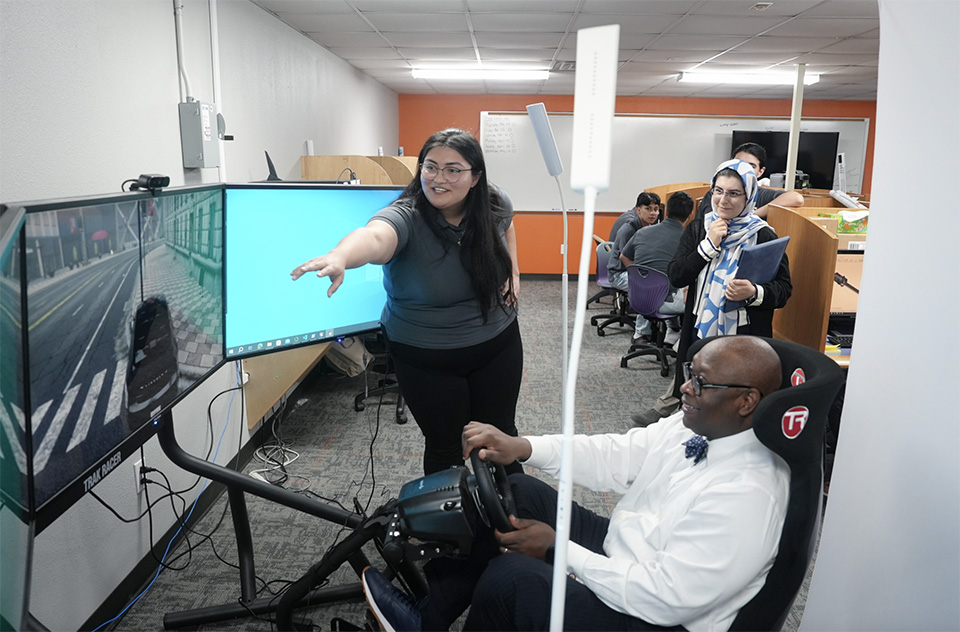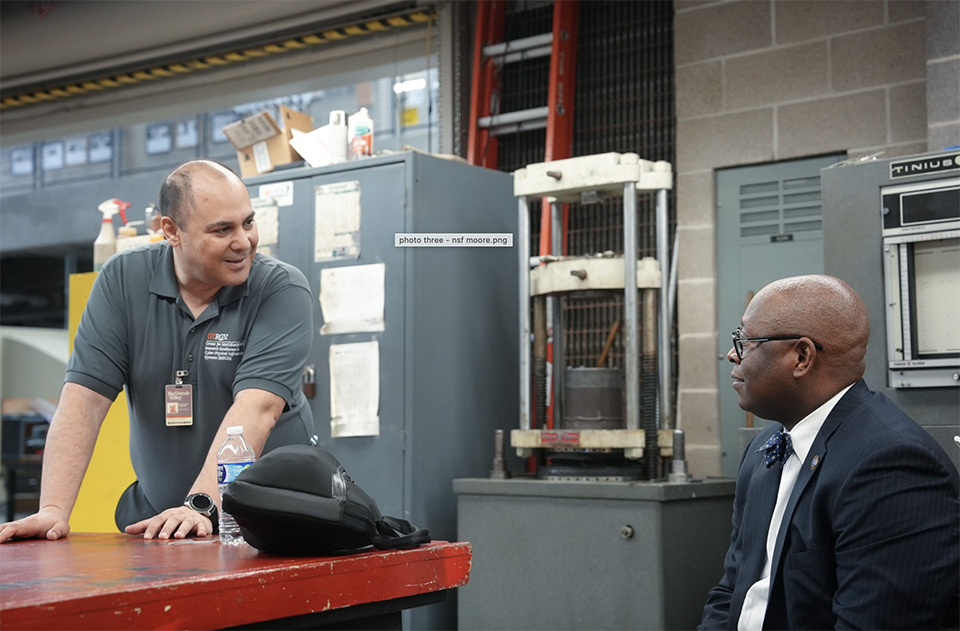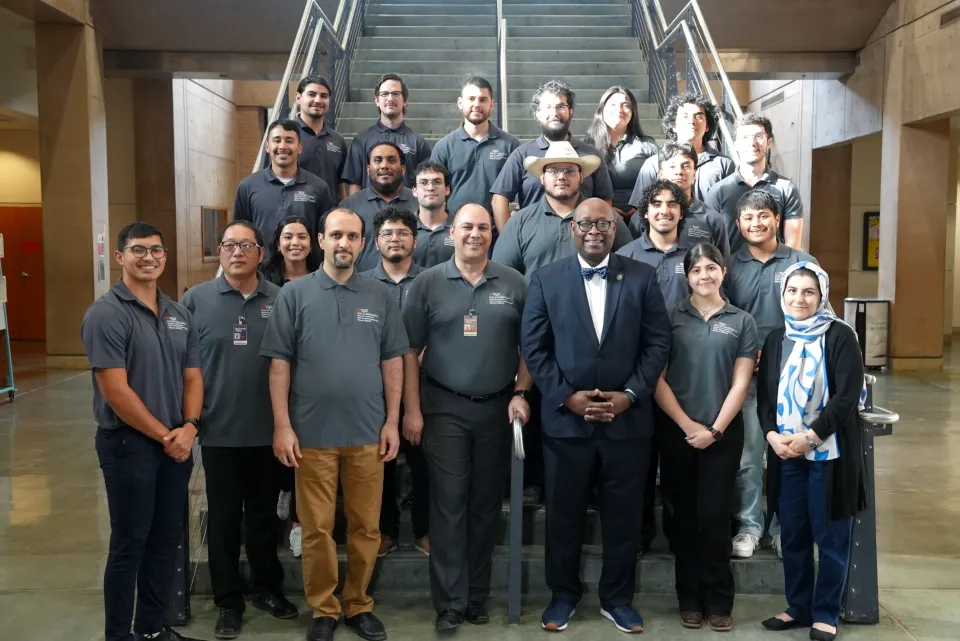By Maria Gonzalez
RIO GRANDE VALLEY, TEXAS – MARCH 6, 2024 – UTRGV recently welcomed Dr. James L. Moore III, assistant director of the Directorate for STEM Education (EDU) at the National Science Foundation (NSF), for a landmark visit to the Rio Grande Valley.
The visit underscored NSF's commitment to advancing STEM education and showcased UTRGV's leadership role in the field, particularly through its CREST Center for Multidisciplinary Research Excellence in Cyber-Physical Infrastructure Systems (MECIS).
As part of his visit, Moore attended the 7th annual STEM Education Conference, founded by Dr. Angela Chapman, who is also a co-PI of CREST MECIS. The conference, which has received sponsorship from CREST MECIS among others for the past two years, explored the theme, “Toward Transformative Practices: Uprooting Foundations of STEM and Planting Rhizomes of Equity and Justice.”
The focus promoted discussions on transformative practices in STEM education and aligned with the visit's themes of equity and innovation.
In his remarks at the conference, Moore highlighted the significance of initiatives like CREST MECIS in promoting STEM education and research.
“CREST is one of our darlings in the agency — it’s the impetus for creating opportunities at emerging institutions like UTRGV,” he said. He also stressed the need for equitable STEM opportunities nationwide.
Highlighting the strategic importance of the Rio Grande Valley, Moore acknowledged the crucial role of higher education institutions in community and academic development.
“I think there’s a compelling case study here at UTRGV that I hope Texas recognizes for its uniqueness,” he said.
Moore emphasized the need for investment in curricula, faculty hires and research infrastructure to effectively support workforce development and research.
After the conference, Moore toured UTRGV's state-of-the-art research facilities on the Edinburg Campus. The tour, focusing on NSF-funded laboratories, was led by Dr. Constantine Tarawneh, senior associate dean for Research and Graduate Programs and director of the CREST MECIS center.
Tarawneh showcased the Center's interdisciplinary approach and its significant impact on enhancing UTRGV's research capabilities and student opportunities.
“We designed the Center to be accessible to students from all disciplines, playing a crucial role in catalyzing their careers, supporting both undergraduate and graduate students,” he said.
He outlined the critical role of CREST MECIS in cyber-physical infrastructure research at Hispanic-Serving Institutes.
“As a critical component in advancing cyber-physical infrastructure research, especially at a Hispanic-Serving Institute,” he said, “the center prepares students with essential research experience at the intersection between artificial intelligence, sensors and automation.”
Tarawneh said this preparation targets the next STEM workforce generation, offering a multidisciplinary and comprehensive educational pathway for underrepresented groups from high school to graduate levels.
He also highlighted how CREST MECIS enhances UTRGV's infrastructure by supporting an engineering doctoral program, encouraging student co-authorship in publications, and facilitating participation in national conferences.
Moore was able to interact with students, including Teresa Garza, an undergraduate computer science student and research assistant at the NSF CREST MECIS center. Garza’s work on the CARLA Simulations project for autonomous vehicles focusing on facial emotion recognition data collection, stands as a prime example of the innovative research supported by NSF at UTRGV.
“Our CARLA Simulations mimic real-life driving — a project that gained significance with Moore's visit. His positive feedback on our simulation reinforced our commitment to developing smarter, safer vehicles,” Garza said. “UTRGV has significantly facilitated success beyond the classroom, crucially addressing the underrepresentation of my demographic in engineering. The success of College of Engineering and Computer Science (CECS) graduates in landing roles with leading companies is a testament to this support.”
For more information about the CREST MECIS center, visit https://www.utrgv.edu/mecis/.
ABOUT UTRGV
The University of Texas Rio Grande Valley (UTRGV) was created by the Texas Legislature in 2013 as the first major public university of the 21st century in Texas. This transformative initiative provided the opportunity to expand educational opportunities in the Rio Grande Valley, including a new School of Medicine and a School of Podiatry, and made it possible for residents of the region to benefit from the Permanent University Fund – a public endowment contributing support to the University of Texas System and other institutions.
UTRGV has campuses and off-campus research and teaching sites throughout the Rio Grande Valley including Brownsville (formerly The University of Texas at Brownsville campus), Edinburg (formerly The University of Texas-Pan American campus), Harlingen, Weslaco, McAllen, Port Isabel, Rio Grande City and South Padre Island. UTRGV, a comprehensive academic institution, enrolled its first class in the fall of 2015; the School of Medicine welcomed its first class in the summer of 2016, and the School of Podiatric Medicine in the fall of 2022.



